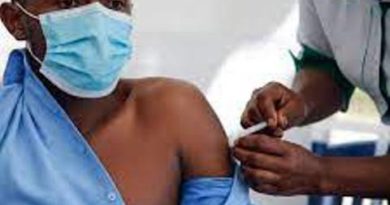Spinal cord injuries during COVID‐19 and How to deal with?
by Dr.B.S.V.Raju, MS, DNB(Ortho), M.Ch(Neuro Surgery); Senior Consultant Neuro & Spine Surgeon, Aster Prime Hospital, Ameerpet, Hyderabad.
The Covid pandemic is affecting everyone, healthy and disabled. People who suffer from back injury in this context are living with doubts about how the injury will heal in many cases for fear of where their health problems will arise. Especially in the wake of the lockdown, they are no longer having to deal with their physical, mental and social needs while later confined to a wheelchair at home. That is why this year, on the occasion of the annual Spinal Injury Day which is being celebrated all over the world, Covid 19 is being organized under the slogan ‘Spinal Injury – Health’.
The World Health Organization estimates that between 250,000 and 500,000 people suffer from back injuries of varying degrees each year. However, a large percentage of these injuries are caused by accidents, falls or violent incidents that can be completely prevented. The U.S. government estimates that back injury treatment costs USD 334,000 to US $ 1 million in the first year and USD 41,000 to 178,000 each year thereafter. In the case of Britain, it is estimated that 2,500 people receive spinal cord injuries each year.
Prevention is Cure
- Always wear a seatbelt when driving or riding in a motor vehicle and use child safety restraints in the vehicle.
- Always wear a helmet when riding a motorcycle or bicycle.
- Never drive a motor vehicle under the influence of alcohol or drugs, or ride with anyone who has.
- Avoid distractions (like phone calls, texting) while driving and pay close attention to the road.
- Follow the speed limits and traffic rules.
- Keep a clean home and eliminating fall hazards inside the house. Slips and falls occur frequently in the home.
- When participating in sports, always use appropriate protective equipment.
- Never dive into shallow and dirty water.
- Use window guards to prevent falls
- Use clinical interventions for risk factors, such as visual impairment, alcohol or substance use.
- Safe road infrastructure, safe vehicles, proper enforcement of traffic rules, and timely and effective emergency care are essential components in reducing incidence of spinal cord injuries.
About Spinal Injuries
Spinal injuries can turn your whole life upside down in an instant so they can be devastating. 21 to 30-year-olds are the age group that are most likely to be spinally injured, but it can happen to people of any age.
There are several different types of spinal injury depending on how far up the spinal cord the damage occurs. Some types of spinal injury will result in paralysis below the site of the injury, and others may not cause paralysis. It all depends on how damaged the spinal cord is.
Spinal cord injury (SCI) and the resultant paralysis has devastating physical, mental, social, sexual and vocational consequences for the injured. In addition, the injury increases the economic burden on the person who sustains an SCI and potentially his or her entire support network.
The spinal cord is a long, fragile tube-like structure that begins at the end of the brain stem and continues down almost to the bottom of the spine. It consists of nerves that carry incoming and outgoing messages between the brain and the rest of the body. The human spinal cord acts as our entire centre for reflexes. It is composed of 26 individual back bones called vertebrae. The vertebrae are separated by disks made of cartilage, which act as cushions, reducing the forces generated by movements such as walking and jumping.
Common causes of SCI:
- Road accidents
- Falls
- Sports injuries
- Assault and violence
- Due to diseases such as arthritis, osteoporosis, infections(TB)
Spinal Cord can indirectly also result in spinal injury disease due to:
- Tumours
- Infections such as meningitis and polio
- Inflammatory diseases
- Autoimmune diseases
- Degenerative disease
Symptoms
Symptoms may include partial or complete loss of sensation and movements of arms, legs and/or body. The most severe spinal cord injury affects the systems that regulate bowel or bladder control, breathing, heart rate and blood pressure.
Spinal fractures or dislocation of a vertebra:
Such fractures can cause bone fragments to pinch and damage the spinal nerves or spinal cord. Generally spinal fractures occur from car accidents, falls, gunshot, or sports. Injuries can range from mild ligament and muscle strains, to fractures and dislocations of the bony vertebrae, to debilitating spinal cord damage. Pain, difficulty walking, paralysis can occur. Many fractures heal with conservative treatment; however severe fractures may require surgery to realign the bones.
Spinal Cord Compression:
Spinal cord compression occurs when a mass places pressure on the cord. A mass can include a tumour or bone fragment. Compression can develop anywhere along the spinal cord from the neck to the lower spine. Some causes include certain degenerative diseases, such as arthritis, ruptured disk, Injury to the spinal cord or the area around the cord can lead to swelling can lead to compression.
Type of spinal cord injury
SCI can be incomplete and complete.
Incomplete spinal cord injuries:
With incomplete injuries, the cord is only partially disconnected, allowing the injured person to retain some function.
Complete spinal cord injuries:
By contrast, complete injuries occur when the spinal cord is fully severed, eliminating function.
Complications of spinal cord injury:
Damage can be either temporary or permanent. These changes translate into loss of muscle function, sensation, or autonomic function in parts of the body served by the spinal cord below the level of the lesion.
Treatment of Spinal Cord Injury includes:
- Immediate treatment is required for SCI since, time between injury and treatment has an impact on the treatment outcome.
- Medicines like corticosteroids often reduce swelling that can damage the spinal cord
- If spinal cord pressure is caused by a growth that can be removed or reduced before the spinal nerves are completely destroyed, paralysis may improve.
- Spinal Cord Injury Surgery is needed in following cases:
- Realign the spinal bones (vertebrae)
- Remove fluid or tissue that presses on the spinal cord (decompression laminectomy)
- Remove bone fragments, disk fragments, or foreign objects
- Fuse broken spinal bones or place spinal braces
Physiotherapy Management and Rehabilitation of spinal cord injury includes the following:
- Stretching exercises to help maintain tendon and muscle length and/or to reduce muscle spasms.
- Flexibility exercises for entire body.
- Breathing exercises to help prevent chest infection and maximize lung function.
- Posture and balance exercises are to help reduce the pain that is associated with impaired balance and posture.
- Improve your functional activities and walking exercises
- Electronic muscle stimulators and exercise equipment are also used.
Goals of Rehabilitation include:
This generally involves an interdisciplinary team to contribute to the rehab process of patient
- Physiotherapy focusing on lower limbs function and on helping with difficulties with mobility
- Occupational therapists address upper limb dysfunction and difficulties in activities of daily living
- bowel and bladder dysfunction and the management of pressure ulcers
- Dealing with emotional and behavioural concerns of the newly injured patient and with any potential cognitive dysfunction with help of physiatrist
- Speech-language for assisting in speaking and swallowing
- Support to family and educating them to take care of patient
Spinal cord injury recovery occurs within the first six months after injury. Any remaining loss of function present after 12 months is much more likely to become permanent. Maintaining a positive outlook is extremely important for patients with spinal cord injury patients.




